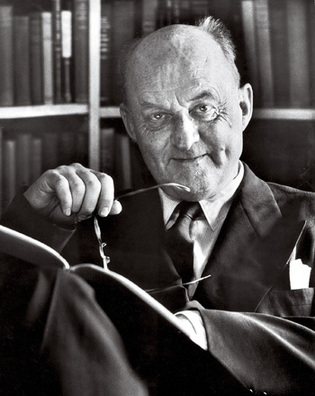 loading
loading
featuresWho wrote the Serenity Prayer?The inspiring text—long attributed to an eminent theologian—may have deeper roots than we thought. Fred R. Shapiro is the editor of nine books, most recently the Yale Book of Quotations, for which he used novel online research methods to trace the sources of misattributed quotations. He writes the Yale Alumni Magazine's "You Can Quote Them" column.  Alfred Eisenstaedt/Pix Inc./Time & Life Pictures/Getty ImagesReinhold Niebuhr (1892–1971) View full imageAt the beginning of this millennium, the editors of the World Almanac selected what they thought to be "the most memorable quotes by Americans in the last 100 years." One of their ten most memorable quotes was the following:
At least in the English- and German-speaking worlds, this is undoubtedly the most famous prayer originated in modern times, probably the only prayer ever to rival the Lord's Prayer in popularity. Billy Pilgrim hung it on his office wall in Slaughterhouse-Five; Bill Clinton ’73JD invoked it repeatedly when he campaigned for the presidency. It has given inspiration and solace to millions of people and has been very prominently employed by Alcoholics Anonymous. Reinhold Niebuhr ’14BDiv, ’15MA, who died in 1971, was a theologian of towering importance who deeply influenced the political life of his time and courageously opposed Nazism in a period when most in his church backed U.S. neutrality. He was an extraordinary and prolific writer and thinker whose ideas continue to shape liberal Protestantism today. Hans J. Morgenthau called him "the greatest living political philosopher of America," and Arthur M. Schlesinger Jr. once said, "Reinhold Niebuhr was the greatest man I knew." Yet he is perhaps best known to the general public because of the "Serenity Prayer." The prayer has long been the target of doubts about its authorship, though many of those doubts were ill-founded. Niebuhr himself, when questioned about the prayer, was unassuming -- he modestly conceded the possibility that he had assimilated its concept from some earlier, forgotten source -- but made clear that he believed he had originated it. Now, new evidence from historical newspaper databases has changed our understanding of its history. The formula of the Serenity Prayer, it is now clear, was circulating before 1936, or at least five years before Niebuhr's family has said he composed it and used it. This evidence is by no means conclusive. It is entirely possible that Niebuhr composed the prayer much earlier than he himself later remembered. But it also appears possible, indeed plausible, that the great theologian was unconsciously inspired by an idea from elsewhere. Niebuhr apparently did not publish the Serenity Prayer himself until 1951, in one of his magazine columns. It had first appeared under his name in 1944, after a friend and neighbor -- Howard Chandler Robbins, who had heard Niebuhr use it in a church service -- asked permission to include it in a Federal Council of Churches book for army chaplains and servicemen. The USO distributed the booklet to hundreds of thousands of servicemen, according to Niebuhr biographer Richard Wightman Fox ’67GRD. The prayer gained fame when, during World War II or soon after, Alcoholics Anonymous ran across it and adopted it as a keystone of the 12-step program. The wording of AA's prayer, still used today, is as follows:
(Niebuhr's preferred version, according to his daughter, was the one that appears at the beginning of this article. But he used different versions. The one in Robbins's 1944 book, based on the text that Niebuhr himself handed to Robbins, is closer to the AA version.) At first, AA did not know of Niebuhr's connection with the prayer and did not attribute it to anyone. In its literature over the years, AA has given detailed but conflicting accounts of how the organization first found the Serenity Prayer -- stating that the prayer was spotted in an obituary in the New York Times or New York Herald Tribune, in 1939 or 1940 or 1941 or 1942. But in careful searches of the online Times and the microfilmed Herald Tribune, I have been unable to verify any of these claims. Whatever the means of transmission were, AA picked up the prayer in a big way. Founder Bill W. wrote in his book, Alcoholics Anonymous Comes of Age: "Never had we seen so much AA in so few words." To this day the prayer remains a mainstay of AA meetings, and it is as a celebrated part of the culture and language of recovery that the Serenity Prayer probably exerts its greatest influence and inspiration. In 1962, Hallmark began using the prayer in its graduation cards. Hallmark credited Niebuhr, but by this time a virtual cottage industry of Serenity Prayer prints and knickknacks had sprung up, and many of these reproductions gave no attribution at all. Today it is possible to buy jewelry, candles, and many kinds of embroidery kits that feature the prayer -- even Zippo lighters.
|
|